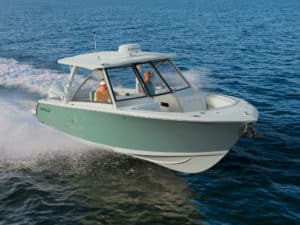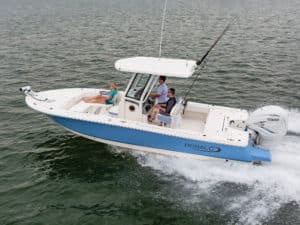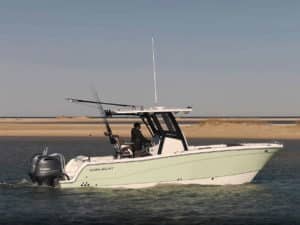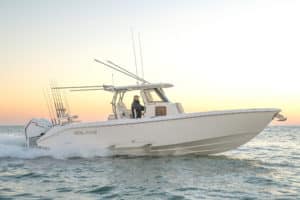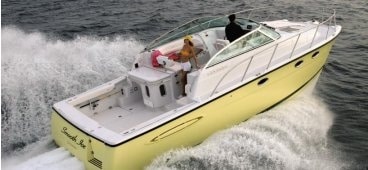
Glacier Bay 3470 Main
Several years ago, I served as navigator for a pair of 26-foot Glacier Bay catamarans crossing 1,350 miles of remote, open ocean from Hawaii to Midway Island. Leaving Hawaii, we headed down-sea in 15- to 18-foot seas. I honestly can’t think of a 26-foot monohull that I would readily agree to sail on such a trip.
Performance
This new 34 runs every bit as well as Glacier Bay’s intrepid 26-footers. But the 3470 has 78 percent more roll stability than a 26-foot Glacier Bay.
Seas outside Miami’s Government Cut ran 4 feet out of the southeast – really not much of a contest. The twin Cummins MerCruiser QSB 5.9 common-rail diesels churning out a quiet 380 hp each were hardly as loud as the wind past my ears as I stood in the cockpit. Glacier Bay installs considerable sound-insulation material on the lids and bulkheads surrounding the engines, making for an exceptionally quiet ride.
The 34 series comes in both inboard and outboard versions. I found it amazing that the difference in the weight and balance ratios of the two versions is only 1 percent. Also interesting, the ratios match those of the 26-footer. Good genes, I guess. Of course, displacement-wise, the inboard tips the scale at 1,800 pounds more than the outboard version.
Don’t expect this boat to feel anything like what you’re used to in a monohull. It tends to remain flat in a hard turn or to even lean outboard slightly. Or it may roll slightly and unexpectedly even in flat water. But remember that this is a high-speed displacement hull, not a planing hull. Translating to layman’s terms: Launch the 3470 off a 4-foot wave at 30 mph and I guarantee you it will be a nonevent. You hardly need to bend your knees.
According to the Mercury SmartCraft engine gauges, idle speed of 600 rpm produced a speed of 5.8 mph, using 1 gallon of diesel per hour total. In flat water, I hit a top speed of 34 mph at 2,900 rpm – pretty respectable for any displacement hull – using 39 gph total. For cruising, 1,900 rpm burned a more conservative 16 gph providing a range of more than 350 miles.
In a drift, the 3470 settles directly abeam of the seas, with the fairly abrupt catamaran-style roll moment.
Fishing
Glacier Bay engineered an excellent rigging and tackle station in the portside cockpit module. When you open the station up, tackle trays fold down automatically. You also get a 47-gallon lighted livewell with an aquarium window.
The cockpit – as you’d expect on a cat – offers tons of fishing space with removable coaming pads all around that met me at the upper thigh. About the only shortcoming from a fishing standpoint is the height of the freeboard around the cockpit. If you want to revive a stressed fish prior to releasing it, it’s a bit of a stretch to the water’s surface when leaning over the rail. However, I have an answer to this. The transom door is large enough to lie down in, and with the tunnel right there, well you can easily see that holding a fish on centerline while idling forward is easier than on a standard monohull.
Glacier Bay provides four rod holders in the gunwales. More can be mounted across the stern and in the side gunwales. One other change: I’d prefer to add removable rod holders in the wide dry-storage box in the transom so that it could double as rod storage. Hard-core anglers will probably eschew the optional swim step that would degrade backing performance. With props so far apart and a tunnel in the center, this boat backs down and spins on a fish better than most.
Design and Construction
Thanks to the transom at the aft extreme rather than outboard brackets, the 3470 provides 21 more inches of cockpit length than the two outboard versions of this boat – a fact serious fisherman should particularly appreciate.
Conceived in the harsh reality of the Pacific Northwest, Glacier Bay bows needed to withstand collisions with submerged logs. Consequently, the company reinforces all its boats’ stems with Kevlar and six to 10 layers of premium E-glass 24-ounce woven roving. The Kevlar runs the full length of the stem and wraps around to the keel. A foam-filled double bottom creates a virtually impregnable, watertight compartment in the bow. Stretching aft are more foam-filled compartments separated by watertight bulkheads. The rest of the hull is solid fiberglass almost an inch thick.
You’ll find quite elegant accommodations below deck with an interesting new feature: A retractable bulkhead affords the master stateroom access to the guest stateroom – in case you want to check up on your offspring.
Despite two individual hulls obviously narrower than a single monohull, living space aboard the Glacier Bay 3470 is most comfortable, even for people of well above average size – like yours truly.
LOA 34 ft.
BEAM 13 ft. 3 in.
DEADRISE Displacement cat
DRAFT 2 ft. 2 in.
WEIGHT 18,700 lb.
FUEL 300 gal.
MAX POWER (2) 380-hp diesels
MSRP $322,350 (base boat)
Glacier Bay Catamarans
Monroe, Washington
360-794-0444
www.glacierbaycats.com
Volvo penta D-6
370-hp Diesel
TYPE In-line 6
DISPL. 359 cid
MAX RPM 3,000
HP/LB RATIO 0.29
FUEL SYSTEM Common rail
GEAR RATIO 1.64:1
WEIGHT 1,296 lb.
ALT. OUTPUT 115 amps
MSRP Price on request
Notable Standard Equipment
* Foam-filled, double-bottom hulls
* Bait-prep center
* 47-gallon baitwell
* Molded swim platform w/integral ladder
* Six watertight compartments w/pumps
* Two 1,350-cubic-foot fish boxes
Impressions
There’s some talk of taking one of these 34s from Ecuador out to the Galapagos. I am impressed enough with this boat to jump at the chance.

